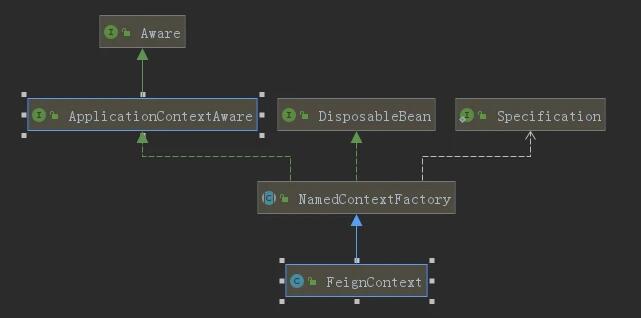您好,登錄后才能下訂單哦!
您好,登錄后才能下訂單哦!
今天小編給大家分享一下如何使用Feign動態設置header的相關知識點,內容詳細,邏輯清晰,相信大部分人都還太了解這方面的知識,所以分享這篇文章給大家參考一下,希望大家閱讀完這篇文章后有所收獲,下面我們一起來了解一下吧。
項目中用到了Feign做遠程調用, 有部分場景需要動態配置header
開始的做法是通過 @RequestHeader 設置參數來實現動態的header配置
@GetMapping(value = "/test", consumes = {MediaType.APPLICATION_JSON_UTF8_VALUE})
String access(@RequestHeader("Auth") String auth, @RequestBody Expression expression);這種方式雖然可以達到header的動態配置, 但是當參數過多時會降低接口可用性, 所以想通過傳遞bean的方式來設置header
public class HeaderInterceptor implements RequestInterceptor {
@Override
public void apply(RequestTemplate requestTemplate) {
byte[] bytes = requestTemplate.requestBody().asBytes();
Identity identity = JSONObject.parseObject(bytes, Identity.class);
requestTemplate.header("Auth", identity.getSecret());
}
}
/**
* configuration指定Interceptor
**/
@FeignClient(name = "test", url = "127.0.0.1:8300", configuration = HeaderInterceptor.class)
public interface GolangTestHandle2 {
@GetMapping(value = "/handler", consumes = {MediaType.APPLICATION_JSON_UTF8_VALUE})
String handle(Identity identity);
}自定義Interceptor實現RequestInterceptor接口, 回調方法apply提供了RequestTemplate對象, 對象內部封裝了request的所有信息, 最后通過configuration指定接口, 之后就隨便你怎么玩了(例如通過body獲取接口參數并動態設置header)
值得注意的一點是HeaderInterceptor如果注入到Springboot容器的話會全局生效, 就是說及時沒有指定configuration也會對全局feign接口生效, 為什么呢? 這里簡單說明一下

首先Feign為每個feign class創建springcontext上下文
spring通過調用getObject獲取feign工廠實例
@Override
public Object getObject() throws Exception {
return getTarget();
}內部調用FeignClientFatoryBean.getTarget()方法
<T> T getTarget() {
//獲取feign上下文
FeignContext context = this.applicationContext.getBean(FeignContext.class);
//構建feign Builder
Feign.Builder builder = feign(context);
...
}根據feign(FeignContext context)構建Builder
protected Feign.Builder feign(FeignContext context) {
FeignLoggerFactory loggerFactory = get(context, FeignLoggerFactory.class);
Logger logger = loggerFactory.create(this.type);
// @formatter:off
Feign.Builder builder = get(context, Feign.Builder.class)
// required values
.logger(logger)
//默認springEncoder
.encoder(get(context, Encoder.class))
//默認OptionalDecoder
.decoder(get(context, Decoder.class))
//默認SpringMvcContrat
.contract(get(context, Contract.class));
// @formatter:on
//配置該feign的context
configureFeign(context, builder);
return builder;
}在構建過程中通過FeignClientFactoryBean.configureUsingConfiguration為feign class注冊基本的配置項, 其中也包括了Interceptor的注冊
protected void configureUsingConfiguration(FeignContext context,
Feign.Builder builder) {
Logger.Level level = getOptional(context, Logger.Level.class);
if (level != null) {
builder.logLevel(level);
}
Retryer retryer = getOptional(context, Retryer.class);
if (retryer != null) {
builder.retryer(retryer);
}
ErrorDecoder errorDecoder = getOptional(context, ErrorDecoder.class);
if (errorDecoder != null) {
builder.errorDecoder(errorDecoder);
}
Request.Options options = getOptional(context, Request.Options.class);
if (options != null) {
builder.options(options);
}
//從feign context獲取interceptors
Map<String, RequestInterceptor> requestInterceptors = context
.getInstances(this.contextId, RequestInterceptor.class);
if (requestInterceptors != null) {
builder.requestInterceptors(requestInterceptors.values());
}
if (this.decode404) {
builder.decode404();
}
}contextId為具體的feign class id, RequestInterceptor為具體的接口, 即是說通過context.getInstances獲取所有RequestInterceptor實例并注冊到builder中.
public <T> Map<String, T> getInstances(String name, Class<T> type) {
AnnotationConfigApplicationContext context = getContext(name);
//使用beanNamesForTypeIncludingAncestors
if (BeanFactoryUtils.beanNamesForTypeIncludingAncestors(context,
type).length > 0) {
return BeanFactoryUtils.beansOfTypeIncludingAncestors(context, type);
}
return null;
}獲取工廠中的實例使用的是beanNamesForTypeIncludingAncestors方法, 該方法不僅會從feign的factory中查找, 也會通過父級別spring工廠查找相應實例(類似于springmvc的工廠)
也是因為該方法, 即使你沒有在FeignClient中配置configuration, 但是你的Interceptor通過@Component等方法注入容器的話也會全局生效的, 所以如果指向讓你的Interceptor部分生效不讓它注入到Spring容器就好
在使用微服務SpringCloud全家桶組件Fegin的時候,我們在進行遠程服務之間調用的同時,為了防止客戶端劫持信息,我們需要將一些敏感信息添加到我們的Fegin頭部(Header)當中,今天朋友問起,總結一下:那么工作中常見的方式有兩種
@PostMapping(value = "/getPersonDetail") public ServerResponse getPersonDetail(@RequestBody Map map,@RequestHeader(name = "id") String id);
使用@RequestHeader(name = "id")可以傳遞動態header屬性
設置Header(所有的Fegin請求)
import org.springframework.context.annotation.Configuration;
import org.springframework.web.context.request.RequestContextHolder;
import org.springframework.web.context.request.ServletRequestAttributes;
import feign.RequestInterceptor;
import feign.RequestTemplate;
@Configuration
public class FeignConfiguration implements RequestInterceptor {
@Override
public void apply(RequestTemplate template) {
ServletRequestAttributes attributes = (ServletRequestAttributes) RequestContextHolder.getRequestAttributes();
HttpServletRequest request = attributes.getRequest();
Enumeration<String> headerNames = request.getHeaderNames();
if (headerNames != null) {
while (headerNames.hasMoreElements()) {
String name = headerNames.nextElement();
String values = request.getHeader(name);
template.header(name, values);
}
}
}
}
@Component
@FeignClient(value = "abc",fallback = abcServiceHystric.class ,configuration = FeignConfiguration.class) public interface AbcService { }以上就是“如何使用Feign動態設置header”這篇文章的所有內容,感謝各位的閱讀!相信大家閱讀完這篇文章都有很大的收獲,小編每天都會為大家更新不同的知識,如果還想學習更多的知識,請關注億速云行業資訊頻道。
免責聲明:本站發布的內容(圖片、視頻和文字)以原創、轉載和分享為主,文章觀點不代表本網站立場,如果涉及侵權請聯系站長郵箱:is@yisu.com進行舉報,并提供相關證據,一經查實,將立刻刪除涉嫌侵權內容。